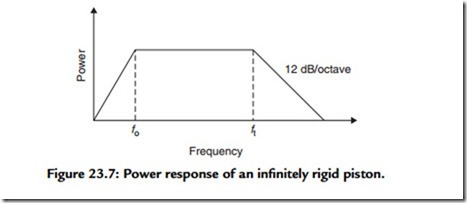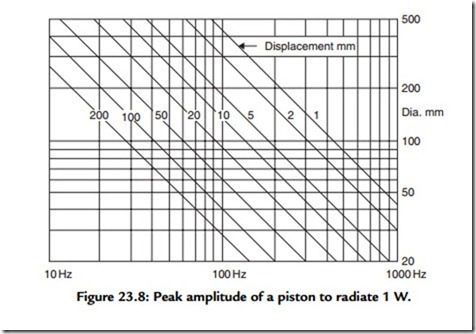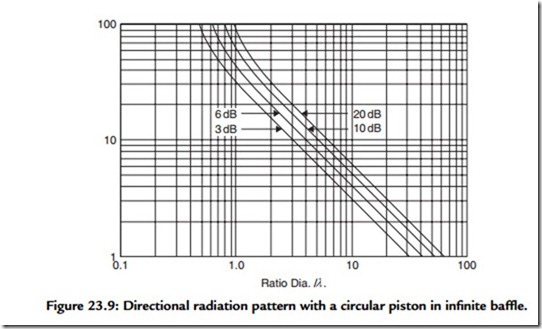Diaphragm Size
It has been found experimentally that the effective area of the cone is its projected or base area. This should not be confused with the advertised diameter of the loudspeaker, which is anything from 25 to 50 mm greater than the effective cone diameter. In direct radiator loudspeakers and at low frequencies, radiation resistance is proportional to the fourth power of the radius (square of the area) and the mass reactance to the cube of the radius. The resistance/reactance ratio (or power factor) of the radiation impedance is therefore proportional to piston radius. Thus the electroacoustic efficiency, other factors being constant, increases with diaphragm area at low frequencies. For constant radiated power, the piston displacement varies inversely with area, hence “long throw” type of small diaphragm area loudspeakers. With fixed amplitude, the radiated power is proportional
to the square of the area at a given frequency, or a frequency one octave lower may be reproduced if the area is increased by a factor of four. The upper limit of diaphragm size is set by increased weight per unit area required to give a sufficiently rigid structure.
Figure 23.8 shows the necessary peak amplitude of a piston mounted in an infinite baffle to radiate one acoustic watt of sound power at various frequencies (one side only of the piston radiating). Peak amplitudes in millimeters are marked on the family of curves. For any other value of acoustic power output (P), multiply peak amplitude by VP. With an average room of 2000 ft3, a reverberation time of 1 s, and a sound pressure level of +94 dB, the total sound output power is of the order of 30 mW. To radiate this power at 50 Hz, the peak amplitude of a 250-mm radiator will be about 2 mm, while a 100-mm piston to radiate the same power would require a peak displacement of just over 13 mm. Even with “long throw” loudspeakers, it is not possible to obtain a peak-to-peak displacement of 26 mm, thus the sound power capabilities must be severely limited at low frequencies. One will often see response curves of these small speakers taken to apparently extraordinarily low frequency limits, but these are always undertaken at low power input levels.
The directional radiation characteristics of a diaphragm are determined by the ratio of the wavelength of the emitted sound to the diaphragm diameter. Increasing the ratio of diaphragm diameter to wavelength decreases the angle of radiation. At frequencies in which the wavelength is greater than four times the diaphragm diameter, the radiation can be considered substantially hemispherical, but as this ratio decreases, the radiation pattern narrows. Figure 23.9 shows the polar response of a piston in terms of the ratio of diameter
over wavelength. This shows the degrees off the normal axis at which the attenuation is 3, 6, 10, and 20 dB (as marked on the curves) as a function of the ratio of the piston diameter over the wavelength of the generated sound wave.


